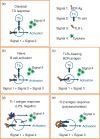Toll-like receptors--sentries in the B-cell response
- PMID: 20067531
- PMCID: PMC2770679
- DOI: 10.1111/j.1365-2567.2009.03173.x
Toll-like receptors--sentries in the B-cell response
Abstract
Toll-like receptors (TLR) play a central role in the initiation of the innate immune response to pathogens. Upon recognition of molecular motifs specific for microbial molecules TLR mediate pro-inflammatory cytokine secretion and enhance antigen presentation; in B cells they further promote expansion, class switch recombination and immunoglobulin secretion. As a result of their adjuvant properties, TLR ligands have become an integral component of antimicrobial vaccines. In spite of this, little is known of the direct effects of TLR engagement on B-lymphocyte function. The scope of this review is to outline the differences in TLR expression and reactivity in murine and human B-cell subsets and to provide an overview of the currently available literature. We will further discuss the possible roles of TLR in regulating B-cell effector functions and shaping antibody-mediated defence against microbial pathogens in vivo.
Figures


Similar articles
-
Toll-like receptors and B-cell receptors synergize to induce immunoglobulin class-switch DNA recombination: relevance to microbial antibody responses.Crit Rev Immunol. 2010;30(1):1-29. doi: 10.1615/critrevimmunol.v30.i1.10. Crit Rev Immunol. 2010. PMID: 20370617 Free PMC article. Review.
-
B cell TLRs and induction of immunoglobulin class-switch DNA recombination.Front Biosci (Landmark Ed). 2012 Jun 1;17(7):2594-615. doi: 10.2741/4073. Front Biosci (Landmark Ed). 2012. PMID: 22652800 Free PMC article. Review.
-
Toll-like receptors and innate immunity in B-cell activation and antibody responses.Curr Opin Immunol. 2007 Jun;19(3):268-74. doi: 10.1016/j.coi.2007.04.002. Epub 2007 Apr 12. Curr Opin Immunol. 2007. PMID: 17433875 Review.
-
Immunostimulatory properties of Toll-like receptor ligands in chickens.Vet Immunol Immunopathol. 2013 Apr 15;152(3-4):191-9. doi: 10.1016/j.vetimm.2012.10.013. Epub 2012 Dec 13. Vet Immunol Immunopathol. 2013. PMID: 23305711 Review.
-
Activation of Both TLR and NOD Signaling Confers Host Innate Immunity-Mediated Protection Against Microbial Infection.Front Immunol. 2019 Jan 14;9:3082. doi: 10.3389/fimmu.2018.03082. eCollection 2018. Front Immunol. 2019. PMID: 30692992 Free PMC article.
Cited by
-
Interleukin 6 Accelerates Mortality by Promoting the Progression of the Systemic Lupus Erythematosus-Like Disease of BXSB.Yaa Mice.PLoS One. 2016 Apr 6;11(4):e0153059. doi: 10.1371/journal.pone.0153059. eCollection 2016. PLoS One. 2016. PMID: 27050763 Free PMC article.
-
Demonstration of innate immune responses in the thyroid gland: potential to sense danger and a possible trigger for autoimmune reactions.Thyroid. 2013 Apr;23(4):477-87. doi: 10.1089/thy.2011.0480. Epub 2013 Mar 18. Thyroid. 2013. PMID: 23234343 Free PMC article.
-
IgM+IgD+CD27+ B cells are markedly reduced in IRAK-4-, MyD88-, and TIRAP- but not UNC-93B-deficient patients.Blood. 2012 Dec 13;120(25):4992-5001. doi: 10.1182/blood-2012-07-440776. Epub 2012 Sep 21. Blood. 2012. PMID: 23002119 Free PMC article.
-
Cell clustering and delay/arrest in T-cell division implicate a novel mechanism of immune modulation by E. coli heat-labile enterotoxin B-subunits.Cell Immunol. 2015 Jun;295(2):150-62. doi: 10.1016/j.cellimm.2015.02.014. Epub 2015 Mar 5. Cell Immunol. 2015. PMID: 25880107 Free PMC article.
-
Oncogenic MYD88 mutations in lymphoma: novel insights and therapeutic possibilities.Cancer Immunol Immunother. 2018 Nov;67(11):1797-1807. doi: 10.1007/s00262-018-2242-9. Epub 2018 Sep 11. Cancer Immunol Immunother. 2018. PMID: 30203262 Free PMC article. Review.
References
-
- Akashi-Takamura S, Miyake K. TLR accessory molecules. Curr Opin Immunol. 2008;20:420–5. - PubMed
-
- Kawai T, Akira S. TLR signaling. Semin Immunol. 2007;19:24–32. - PubMed
-
- Takeda K, Kaisho T, Akira S. Toll-like receptors. Annu Rev Immunol. 2003;21:335–76. - PubMed
-
- Bekeredjian-Ding I, Doster A, Schiller M, Heyder P, Lorenz HM, Schraven B, Bommhardt U, Heeg K. TLR9-activating DNA up-regulates ZAP70 via sustained PKB induction in IgM+ B cells. J Immunol. 2008;181:8267–77. - PubMed
-
- Gerondakis S, Grumont RJ, Banerjee A. Regulating B-cell activation and survival in response to TLR signals. Immunol Cell Biol. 2007;85:471–5. - PubMed
Publication types
MeSH terms
Substances
LinkOut - more resources
Full Text Sources
Other Literature Sources
Research Materials

